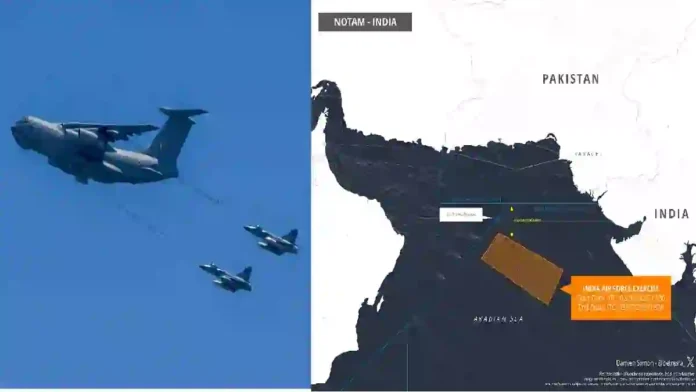The Indian Air Force (IAF) is preparing to conduct a significant two-day aerial exercise in the Arabian Sea region, in close proximity to Pakistani airspace. The designated drill zone is strategically located about 200 nautical miles off the Karachi coast, with certain portions of the exercise extending to within 70 nautical miles of the airspace controlled by Pakistan.
The exercise is scheduled to commence on September 2 at 11:00 AM IST and conclude on September 3 at 2:00 PM IST. While the timing and location of the drills highlight the operational readiness of the Indian armed forces in strategically sensitive zones, officials have described the activity as a routine training manoeuvre rather than a provocation.
Read- How India’s Advanced Integrated Air Defence Weapon System Works
In line with international aviation safety protocols, a Notice to Airmen (NOTAM) has been issued to disseminate the necessary advisory information to aviation stakeholders across the region.
A NOTAM is a critically important tool in the field of aviation, serving as an official communication medium through which pilots and air traffic authorities are informed about temporary hazards, restricted airspaces, or alterations to existing navigational procedures.
These notices are time-sensitive, ensuring that changes in airspace usage, temporary suspensions of services, or any safety-related concerns are immediately conveyed to the aviation community. Issued in compliance with the Convention on International Civil Aviation (CICA), NOTAMs adhere to internationally accepted formats and employ a standardised set of abbreviations to facilitate precise and unambiguous understanding.
In the case of the upcoming Indian Air Force drills, the issued NOTAM ensures that regional and international airlines, as well as private operators, can make the necessary adjustments to flight planning and routing in order to maintain safe separation from military activities.
The choice of the Arabian Sea region, particularly an area mapped so close to Pakistan’s air defence identification zone (ADIZ), underscores both the operational and geopolitical dimensions of such an exercise.
Read- Sukhoi Su-57 Stealth Fighters To Be Made In India?
Read- Rajnath Singh Announces Progress On Indigenous Powerful Jet Engine
From a strategic standpoint, the Indian Air Force benefits from the opportunity to test its aircraft, communication systems, and combat readiness in an operationally sensitive environment. Training in such areas sharpens preparedness in scenarios that could emerge during real-world contingencies, especially in instances of heightened regional tensions.
While defence officials consistently characterise these manoeuvres as part of routine training cycles, the location of the drills near Pakistani airspace is likely to draw close scrutiny from Islamabad, which generally monitors Indian military exercises in nearby regions with considerable vigilance.
Beyond the immediate tactical and strategic implications, the exercise highlights India’s emphasis on maintaining credible force projection capabilities across its western maritime front.
In recent years, the Arabian Sea has become an increasingly significant zone, not only because of its proximity to Pakistan but also due to its relevance in India’s wider maritime security calculus, including energy shipping lanes, trade routes, and the need to counter potential threats originating from state or non-state actors.
Read- Modi says Russia and India stand together even in difficult times
Conducting such drills in this strategically vital maritime corridor signals both a demonstration of strength and an assertion of India’s operational presence.
Overall, the planned two-day Indian Air Force exercise in the Arabian Sea represents more than just a routine training operation. It reinforces the IAF’s continuing emphasis on strategic preparedness, interoperability of forces, and operational safety within international aviation norms.
Through the careful issuance of NOTAMs, India ensures compliance with global aviation safety standards while simultaneously pursuing a training agenda that reinforces national security imperatives.
While the activity has been officially described as routine and precautionary in nature, its proximity to sensitive airspace ensures that it will be closely observed both regionally and internationally, underlining the enduring geopolitical significance of such military manoeuvres.
Based On Republic World Report
Agency




